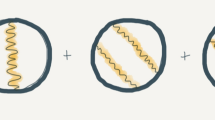Abstract
Quantum mechanics is a fundamental theory that represents physical processes at atomic and sub-atomic level. It is an extraordinarily successful theory, but its interpretation has been the subject of endless controversies. Quantum mechanics and its further developments such as quantum field theory have been invoked to justify beliefs in idealism, the independent existence of the mind, infinite worlds, and almost anything imaginable. In this chapter I review the basic assumptions of both quantum mechanics and quantum field theory and present an analysis of their ontological implications. I evaluate the concept of matter in the light of both theories and conclude that, far from being idealistic theories, they agree with a fully materialistic view of the world.
Access this chapter
Tax calculation will be finalised at checkout
Purchases are for personal use only
Similar content being viewed by others
Notes
- 1.
Bohr (1987), p. 54.
- 2.
Heisenberg (1962), p. 145.
- 3.
Wigner (1995), p. 248.
- 4.
Feynman (1965), p. 129.
- 5.
The problem of measurement might be enunciated more precisely saying that quantum systems evolve in a superposition of states before a measurement. The measurement, however, always reveals a definite particular state. See the end of Sect. 4.3.
- 6.
A Hilbert space is an abstract vector space possessing the structure of an inner product that allows lengths and angles to be measured. Hilbert spaces are complete in the sense that there are enough limits in the space to allow the techniques of calculus to be used.
- 7.
In this definition the symbol ∗ designates the conjugate-complex of the wave function.
- 8.
Heisenberg (1958), p. 28.
- 9.
von Neumann (1955) (original 1932).
- 10.
London and Bauer (1939), p. 252.
- 11.
This is not the only realist and objective interpretation that can be proposed for quantum mechanics. The Many-Worlds interpretation, for instance, adopts the collapse postulate and interprets it at face value accepting an ontological inflation. The overabundant ontology that results is perfectly compatible with materialistic views. This article is not the place to discuss the different arguments for and against these and other interpretations. Rather, the point to be emphasized here is the fact that quantum mechanics can be consistently understood in a way such that the theory does not imply a challenge for materialism. For discussions about interpretations of quantum mechanics see Ruetche (2011) and Acuña (2019).
- 12.
For interacting particles the tensor product should be considered.
- 13.
For simplicity I consider here a scalar field.
- 14.
All theories discussed here are renormalizable.
References
Acuña, P. 2019. Charting the landscape of interpretation, theory rivalry, and underdetermination in quantum mechanics. Synthese. https://doi.org/10.1007/s11229-019-02159-z
Aspect, A., Grangier, P., and G. Roger. 1981. Experimental tests of realistic local theories via Bell’s Theorem. Physical Review Letters 47: 460–463.
Aspect, A., Dalibard, J., and G. Roger 1982. Experimental test of Bell’s Inequalities using timevarying analyzers. Physical Review Letters 49: 1804–1807.
Bell, J.S. 1964. On the Einstein Podolsky Rosen paradox. Physics 1(3): 195–200.
Bell, J.S. 1966. On the problem of hidden variables in quantum mechanics. Reviews of Modern Physics 38: 447–452.
Bell, J.S. 2004. Speakable and Unspeakable in Quantum Mechanics, 2nd ed. Cambridge: Cambridge University Press.
Birrell n.d., and P.C.W. Davies. 1982. Quantum Fields in Curved Space. Cambridge: Cambridge University Press.
Bohr, N. 1987. The Philosophical Writings of Niels Bohr, Vol. I. Woodbridge, Connecticut: Ox Bow.
Bunge, M. 1956. A survey of the interpretations of quantum mechanics. American Journal of Physics 24: 272–286.
Bunge, M. 1967. Foundations of Physics. New York: Springer-Verlag.
Bunge, M. 1973. Philosophy of Physics. Dordrecht: Reidel.
Bunge, M. 1974. Treatise on Basic Philosophy, Vol.1: Sense and Reference. Dordrecht: Kluwer.
Bunge, M. 1977. Interpretation of Heisenberg’s Inequalities. In Denken und Umdenken, ed. H. Pfeiffer. Munchen: R. Piper & Co., Verlag, pp. 146–156.
Davies, P.C.W. 1975. Scalar particle production in Schwarzschild and Rindler metrics. Journal of Physics A 8: 609–616.
Davies, P.C.W. 1984. Particles do not exist, in: Quantum Theory of Gravity, ed. S.M. Christensen. Bristol: Adam Hilger, Bristol, pp. 66–77.
Dirac, P.A.W. 1930, The Principles of Quantum Mechanics. Oxford: Oxford University Press.
Earman, J. 1986. A Primer on Determinism. Dordrecht, Holland: D. Reidel.
Eckart, C. (1926). Operator calculus and the solution of the equation of quantum dynamics. Physics Reviews 28: 711–726.
Einstein, A., B. Podolsky, and N. Rosen. 1935. Can quantum-mechanical description of physical reality be considered complete? Physical Review 47(10): 777–780.
Feynman, R. 1965. The Character of Physical Law. New York: Modern Library.
Freedman, S.J., and J.F. Clauser. 1972. Experimental test of local hidden-variable theories. Physical Review Letters 28(938): 938–941.
Heisenberg, W. 1958. Physics and Philosophy: The Revolution in Modern Science. London: George Allen & Unwin.
Heisenberg, W. 1962. Physics and Philosophy. New York: Harper and Row.
Hobson, A. 2013. There are no particles, there are only fields. American Journal of Physics 81: 211–223.
Jammer, M. 1974. The Philosophy of Quantum Mechanics: the Interpretations of Quantum Mechanics in Historical Perspective. New York: Wiley.
Lewis, P.J. 2016. Quantum Ontology: A Guide to the Metaphysics of Quantum Mechanics. Oxford: Oxford University Press.
London, F., and E. Bauer. 1939, La théorie de l’observation en mécanique quantique. Paris: Hermann, 1939. Translated in: J.A. Wheeler and W.H. Zurek. 1984. Quantum theory and measurement. Princeton: Princeton University Press.
López Armengol, F., and G.E. Romero. 2017. Interpretation misunderstandings about elementary quantum mechanics. Metatheoria 7(2): 55–60.
Margenau, H. 1954. Adventages and disadvantages of various interpretations of the quantum theory. Physics Today 7: 6–13.
Messiah, A. 2014. Quantum Mechanics. Mineola: Dover.
Norsen, T. 2017. Foundations of Quantum Mechanics. Cham: Springer.
Oriti, D. (ed.) 2009. Approaches to Quantum Gravity. Toward a New Understanding of Space, Time and Matter. Cambridge: Cambridge University Press.
Perez Bergliaffa, S.E., G.E. Romero, and H. Vucetich. 1993. Axiomatic foundations of non-relativistic quantum mechanics: A realistic approach, International Journal of Theoretical Physics 32: 1507–1522.
Perez Bergliaffa, S.E., G.E. Romero, H. Vucetich. 1996. Axiomatic foundations of quantum mechanics revisited: The case for systems. International Journal of Theoretical Physics 35: 1805–1819.
Ruetche, L. 2011. Interpreting Quantum Theories. Oxford: Oxford University Press.
Romero, G.E. 2013. Adversus singularitates: The ontology of space-time singularities. Foundations of Science 18: 297–306.
Romero, G.E. 2017. On the ontology of spacetime: Substantivalism, relationism, eternalism, and emergence. Foundations of Science 22: 141–159.
Romero, G.E. 2018. Scientific Philosophy. Cham: Springer.
Schlosshauer, M. 2007. Decoherence and the Quantum-to-Classical Transition. Berlin, Heidelberg, New York: Springer.
Schrödinger, E. 1926. Über das Verhältnis der Heisenberg-Born-Jordanschen Quantenmechanik zu der meinen. Annals of Physics 79: 734–756.
Unruh, W.H. 1976. Notes on black hole evaporation. Physical Review D 14: 870–892.
von Neumann, J. 1955 (original 1932). Mathematical Foundations of Quantum Mechanics. Princeton: Princeton University Press.
Wigner, E.P. 1995. Philosophical Reflections and Syntheses. Berlin and Heidelberg: Springer
Acknowledgements
I am grateful to an anonymous reviewer for useful remarks. This work was supported by the Argentine agencies CONICET (PIP 2014-00338) and ANPCyT (PICT-2017-2865), as well as by the Spanish Ministerio de Economía y Competitividad (MINECO/FEDER, UE) under grant AYA2016-76012-C3-1-P and PID2019-105510GB-C31.
Author information
Authors and Affiliations
Editor information
Editors and Affiliations
Rights and permissions
Copyright information
© 2022 Springer Nature Switzerland AG
About this chapter
Cite this chapter
Romero, G.E. (2022). Quantum Matter. In: Romero, G.E., Pérez-Jara, J., Camprubí, L. (eds) Contemporary Materialism: Its Ontology and Epistemology. Synthese Library, vol 447. Springer, Cham. https://doi.org/10.1007/978-3-030-89488-7_4
Download citation
DOI: https://doi.org/10.1007/978-3-030-89488-7_4
Published:
Publisher Name: Springer, Cham
Print ISBN: 978-3-030-89487-0
Online ISBN: 978-3-030-89488-7
eBook Packages: Religion and PhilosophyPhilosophy and Religion (R0)




